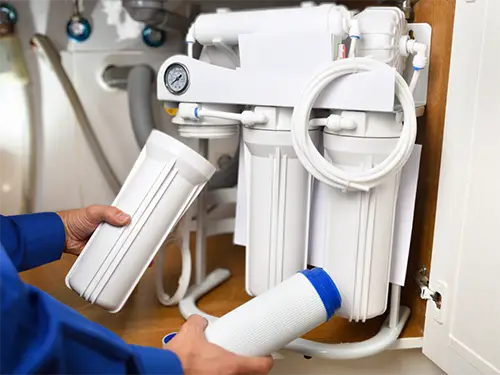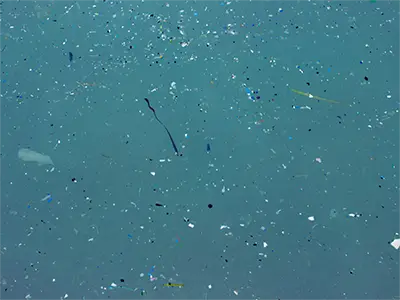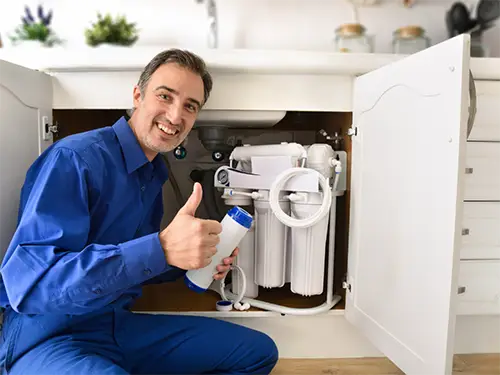 Microplastics are becoming a huge environmental concern. These tiny particles have infiltrated everything from oceans to drinking water, and people are understandably worried about what this means for our health.
Microplastics are becoming a huge environmental concern. These tiny particles have infiltrated everything from oceans to drinking water, and people are understandably worried about what this means for our health.You might have already seen headlines or studies about microplastics in food, water, or even the air we breathe. As the problem grows, many are turning to water filtration systems, particularly reverse osmosis (RO), to tackle the issue head-on. But does reverse osmosis actually remove microplastics from your drinking water?
That’s what we’re here to find out. In this article, we’ll explore how RO systems work, how well they filter microplastics, and why this might be your best bet for ensuring cleaner, safer water. Plus, if you’re in Niceville, Florida, the pros at Benjamin Franklin Plumbing can help install an RO system in your home.
Key Takeaways
- Microplastics are tiny plastic particles less than 5 millimeters in size, commonly found in our water supply.
- Reverse osmosis systems are the most effective method for removing microplastics from drinking water.
- Standard water filters can reduce microplastics but may not eliminate them entirely.
- Long-term solutions to reduce microplastic pollution include reducing plastic use and using filtration systems.
- Benjamin Franklin Plumbing offers reverse osmosis water filtration installation services in Niceville, FL.
What Are Microplastics?
Microplastics are tiny pieces of plastic that have broken down from larger plastic waste or are manufactured intentionally at a microscopic size (like microbeads in personal care products). These particles measure less than 5 millimeters in diameter, but their size doesn’t make them any less harmful. In fact, it’s the opposite. Their small size allows them to travel through our environment and, unfortunately, right into our water supply.
Microplastics come from all sorts of places. Take the plastic bottle you drink from. Over time, it breaks down into smaller and smaller pieces.
The same happens to plastic bags, containers, and utensils. These tiny particles eventually end up in our oceans, rivers, and even in our groundwater.
Here’s a disturbing fact: a study found that 94% of water samples from the U.S. contained microplastics. That’s right — the water you drink could very well contain microscopic plastic particles. And while you can’t see them, they could be having an effect on your health and the environment.
Where Do Microplastics Come From?
 Microplastics don’t just magically appear in your water. They come from a variety of sources, and their spread is linked to everyday items we all use. Here are a few common sources:
Microplastics don’t just magically appear in your water. They come from a variety of sources, and their spread is linked to everyday items we all use. Here are a few common sources:
- Breakdown of Disposable Plastics: Single-use plastics like water bottles and plastic utensils are major culprits. These items break down over time, shedding tiny plastic particles.
- Personal Care Products: Microbeads, which used to be found in products like facial scrubs and toothpaste, are tiny pieces of plastic that get washed down the drain and end up in our water systems.
- Synthetic Clothing: Every time you wash your favorite polyester jacket or nylon shirt, it sheds microfibers into the water. These fibers are too small to be filtered out during wastewater treatment.
- Poor Waste Management: When plastic waste isn’t properly disposed of or recycled, it can end up breaking down in landfills or the ocean, contributing to the spread of microplastics.
From there, microplastics make their way into our drinking water through a variety of pathways — groundwater contamination, sewer overflows, and even airborne particles. Yes, microplastics can literally rain down on us.
Health Risks of Microplastics
So, why should we care about microplastics in our water? Well, while research is still ongoing, there are some health risks that scientists are beginning to uncover. One major concern is that chemicals in plastics can disrupt hormones. Microplastics can hold chemicals that disrupt our body’s natural hormone balance when we consume them.
Another potential issue is inflammation. Consuming plastic particles could trigger an immune response in the body, leading to long-term health problems. And, to make matters worse, microplastics can serve as carriers for harmful pathogens like bacteria and viruses. These particles can hitch a ride on the plastic, sneaking their way into our systems.
We still don’t know the full extent of the risks, but what we do know is enough to make anyone want cleaner, safer drinking water.
Do Water Filters Remove Microplastics?
 You might be wondering if your standard water filter can handle these microplastics. Well, the answer is a bit of a mixed bag. Yes, certain filters can reduce the amount of microplastics in your water, but not all filters are created equal.
You might be wondering if your standard water filter can handle these microplastics. Well, the answer is a bit of a mixed bag. Yes, certain filters can reduce the amount of microplastics in your water, but not all filters are created equal.
Microplastics can be as small as 2.5 microns, which means filters need to have very fine pores to catch them. Here’s how different types of filters measure up:
- Carbon Filters: These can reduce microplastics but won’t completely remove them. They’re better than nothing, but they’re not the most effective option.
- Granular Activated Carbon (GAC) vs. Carbon Block Filters: Both of these carbon-based filters work to remove larger particles, but carbon block filters tend to be more effective because they have smaller pores.
- Reverse Osmosis Filters: Now, here’s where things get interesting. RO systems have a pore size of just 0.0001 microns. That’s tiny. In fact, it’s small enough to remove nearly all microplastics from your water.
Reverse Osmosis is the Most Effective Method for Removing Microplastics
Most municipal filtration systems don’t catch microplastics. Standard filtration methods just aren’t fine enough to trap these particles.
Reverse osmosis, however, is an entirely different story. It filters water by pushing it through a special membrane. This membrane has tiny holes that remove microplastics. It also eliminates harmful substances like heavy metals and chemicals.
If you want the cleanest water possible — free from microplastics — reverse osmosis is your best bet. It’s the gold standard for microplastic removal, especially for tap water.
Other Ways to Limit Microplastic Exposure
Aside from filtering your water, there are other practical steps you can take to limit your exposure to microplastics. These solutions aren’t just good for your health — they help reduce plastic pollution in general.
- Limit Single-Use Plastics: Ditch disposable water bottles and opt for reusable ones. Every little bit helps.
- Proper Disposal and Recycling: Make sure plastic waste is disposed of responsibly. When plastic ends up in landfills or oceans, it contributes to the microplastic problem.
- Reduce Laundry Microfibers: Washing synthetic clothing less frequently can cut down on microplastic shedding. You can also use a fiber filter in your washing machine to catch some of those pesky microfibers.
- Use Water Filters: Install a water filter, preferably a reverse osmosis system, to remove microplastics from your drinking water.
Water Filtration Solutions in Niceville, FL
![]() If you live in Niceville, FL, and you’re concerned about microplastics in your water, you’re in luck. Benjamin Franklin Plumbing offers a variety of water filtration systems, including reverse osmosis filters. Their team of punctual plumbers can help you choose the right system for your home and make sure it’s installed quickly and efficiently.
If you live in Niceville, FL, and you’re concerned about microplastics in your water, you’re in luck. Benjamin Franklin Plumbing offers a variety of water filtration systems, including reverse osmosis filters. Their team of punctual plumbers can help you choose the right system for your home and make sure it’s installed quickly and efficiently.
The best part? They respect your time and your home. You won’t be left waiting around for hours, and their installation process is always clean and respectful.
Final Thoughts
Microplastics are everywhere, but that doesn’t mean you have to drink them. Reverse osmosis is the most effective way to filter these tiny particles from your water. If you’re serious about cleaner water, investing in an RO system could make a world of difference. And beyond that, reducing your plastic use and recycling properly can help combat the spread of microplastics in the first place.
If you’re in Niceville or the surrounding areas, give Benjamin Franklin Plumbing a call. They’ll set you up with the right water filtration system for your needs.
FAQs
If you’re new to reverse osmosis filters or curious about how they handle microplastics, we’ve got answers to the most common questions below. Here’s what you need to know to make an informed choice about your water filtration options.
What size microplastics can reverse osmosis filters remove?
Reverse osmosis filters can remove microplastics down to 0.0001 microns. Since most microplastics are between 1 and 5 millimeters, this means RO filters catch even the tiniest particles.
Can reverse osmosis remove other contaminants besides microplastics?
Yes! RO filters are excellent at removing a wide range of contaminants, including heavy metals, chemicals, and bacteria.
Is reverse osmosis better than a regular carbon filter for removing microplastics?
Absolutely. While carbon filters can reduce microplastics, they don’t remove them completely. Reverse osmosis is far more effective because of its incredibly fine membrane.
How often should I change my reverse osmosis filter?
It’s generally recommended to change the RO filters every 6-12 months, depending on the manufacturer’s guidelines and how much water you use.
Does reverse osmosis waste a lot of water?
RO systems do produce some wastewater during the filtration process, but many modern systems are more efficient and reduce waste. You can also capture and reuse the wastewater for other purposes, like gardening.
Can reverse osmosis filters remove microplastics from bottled water?
While some bottled waters claim to be filtered, there’s no guarantee they’re free of microplastics unless the manufacturer specifically uses reverse osmosis. If you’re concerned about microplastics in bottled water, using your own RO system at home is the best way to control what you’re drinking.
Will reverse osmosis remove beneficial minerals from my water?
Yes, reverse osmosis removes nearly all minerals from water, including beneficial ones like calcium and magnesium. However, you can add a remineralization filter to your RO system to reintroduce healthy minerals into your water after filtration.
How do I know if my tap water contains microplastics?
It’s hard to tell just by looking. The only way to know for sure is to test your water or assume that, given the widespread contamination, microplastics are present in most untreated water sources.
Is it difficult to install a reverse osmosis system?
Not at all, especially if you hire a professional plumber. Benjamin Franklin Plumbing, for example, makes the installation process quick and painless, so you can start enjoying filtered water right away.